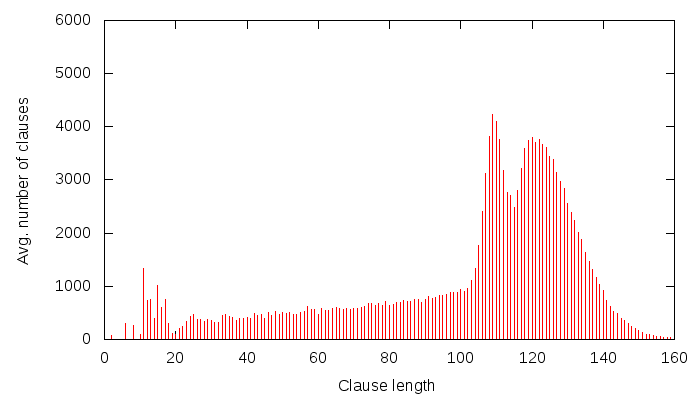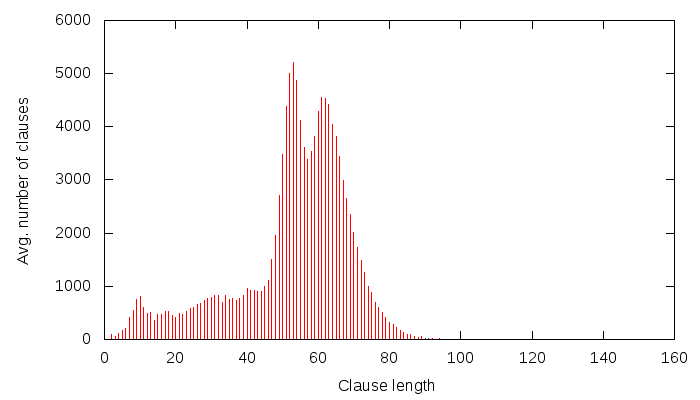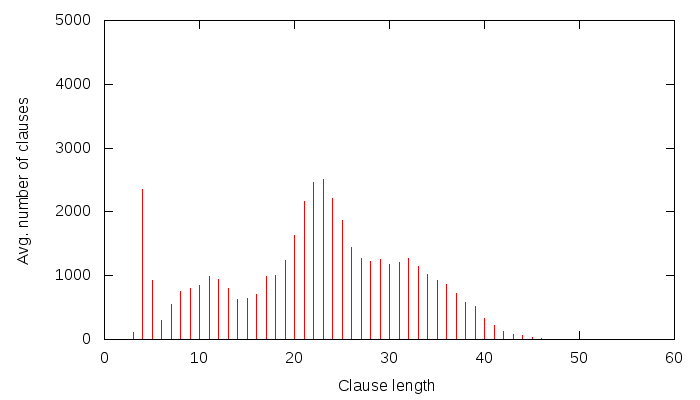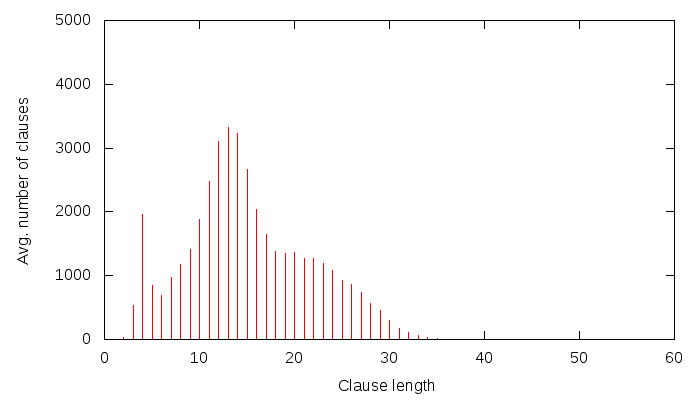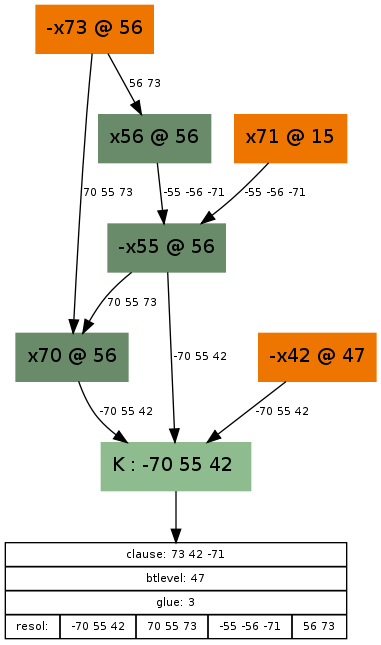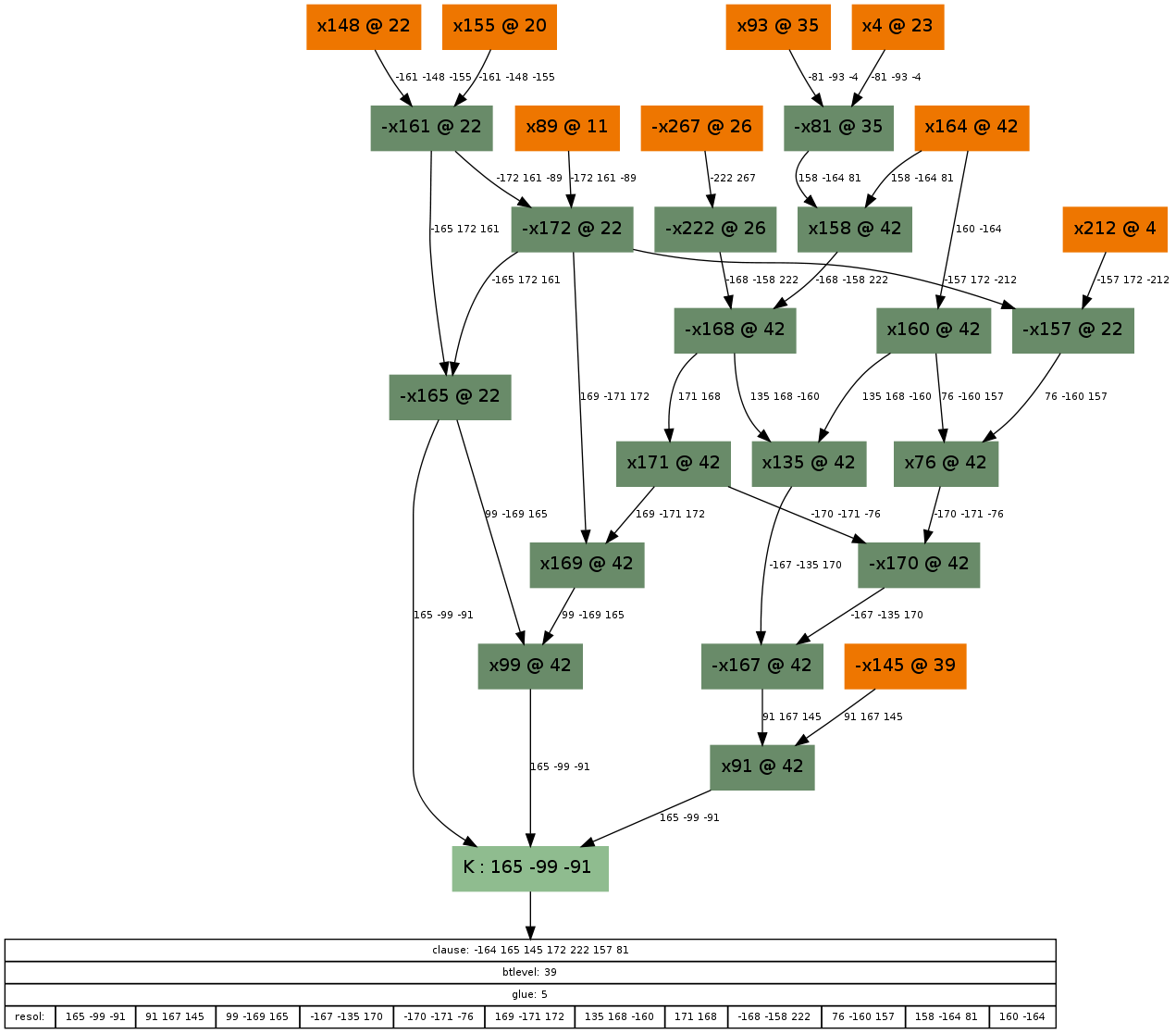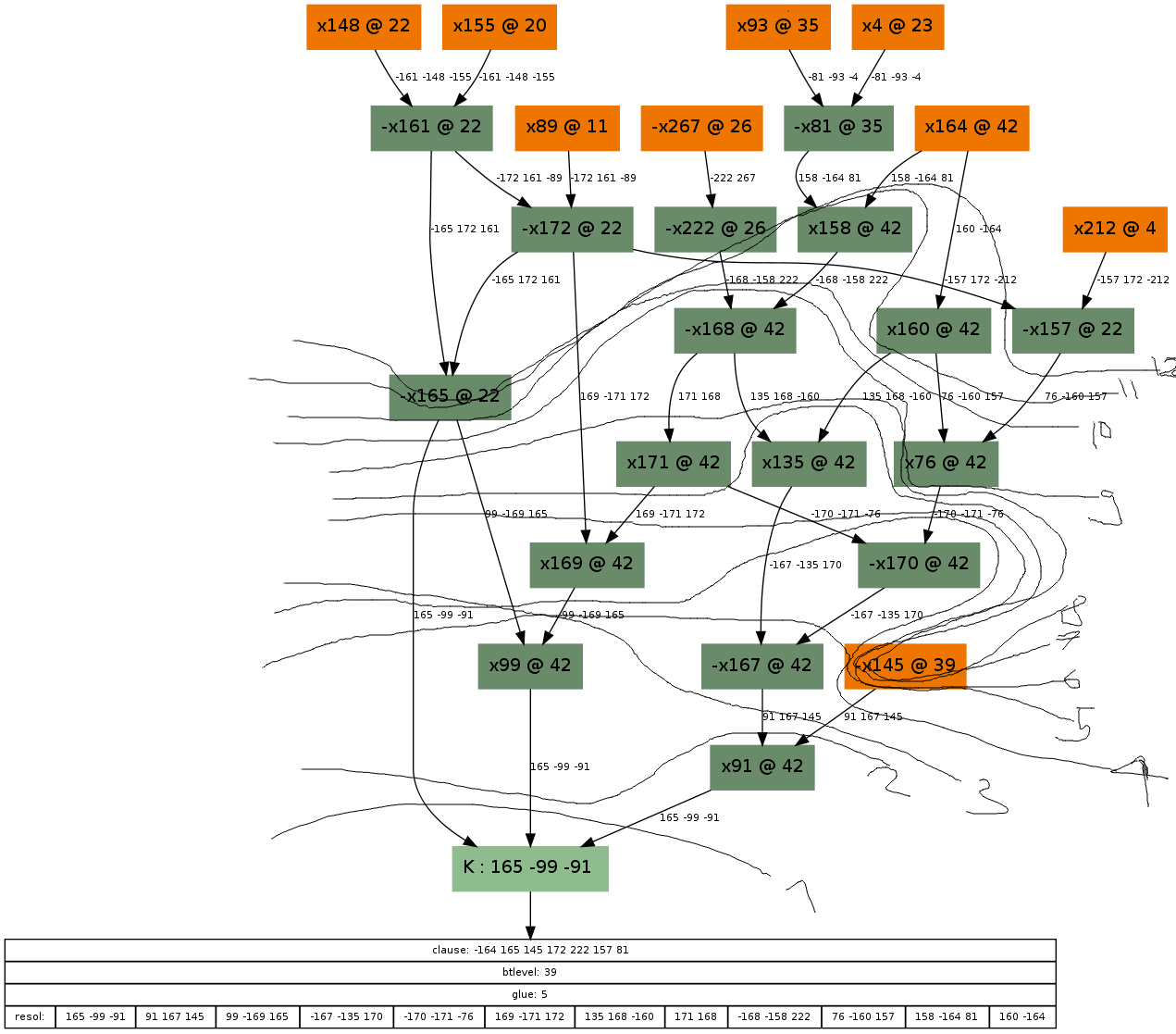Let’s examine why it’s hard to eliminate variables. I remember the code I looked at in SatElite that did it: it was crazy clean code and looked like it was pretty easy to perform. In this post I’ll examine how that simple code became more than a 1’000 lines of code today.
What needs to be done, at first sight
At first sight, variable elimination is easy. We just:
- Build occurrence lists
- Pick a variable to eliminate
- Resolve every clause having the positive literal of the variable with negative ones.
- Add newly resolved clauses into the system
- Remove original clauses.
- Goto 2.
These are all pretty simple steps at first sight, and one can imagine that implementing them is maybe 50-100 lines of code, no more. So, let’s examine them one-by-one to see how they get complicated.
Building occurrence lists
The idea is that we simply take every single clause, and for every literal they have, we insert a pointer to the clause into an array for that literal’s occurrences. This sounds easy, but what happens if we are given 1M clauses, each with 1000 literals on average? If you think this is crazy, it isn’t, and does in fact happen.
One option is we estimate the amount of memory we would use and abort early because we don’t want to run out of memory. So, first we check the potential size, then we link them in. Unfortunately, this means we can’t do variable elimination at all. Another possibility is that we link in clauses only partially. For example, we don’t link in clauses that are redundant but too long. Redundant clauses are ignored during resolution when eliminating, so this is OK, but then we will have to clean these clauses up later, when finishing up. However, if a redundant clause that hasn’t been linked in backward-subsumes an irredudant clause (and thus becomes irredundant itself), we have to link it in asap. Optimisation leads to complexity.
We don’t just want to link these clauses in to some random datastructure. I believe it was Armin Biere who put this idea into my head, or maybe someone else, but re-using watchlists for occurrence lists means we use our memory resources better: there won’t be so much fragmentation. Furthermore, an advanced SAT solver uses implicit binary & tertiary clauses, so those are linked in already into the watchlists. That saves memory.
Picking a variable to eliminate
The order in which you eliminate clauses is a defining part of the speed we get with the final solver. It is crucially important that this is done well. So, what can we do? We can either use some heuristic or precisely calculate the gain for each variable, and eliminate the best guess/calculated one first. These are both greedy algorithms but I think given the complexity of the task, they are the best at hand.
Using precise calculation is easy, we just resolve all the relevant clauses but don’t add the resolvents. It’s very expensive though. A better approach is to use a heuristic. Logically, clauses that have few literals in them are likely not to resolve such that they become tautologies. It’s unlikely that two binary clauses’ resolvent becomes a tautology. It’s however likely that large clauses become tautological once resolved. I take this into account when calculating elimination cost for variable. Since redundant clauses are linked in the occurrence lists so that I can subsume them, I have to skip them.
It’s not enough to calculate the heuristic once, of course. We have to re-calculate after every elimination — the playing field has changed. Thus, for every clause you removed, you have to keep in mind which variables were affected, and re-calculate the cost for each after every variable elimination.
Resolving clauses
The base is easy. We add literals to a new array of literls and mark the literals that have been added in a quick-lookup array. If the opposite of a literal is added, the markings tell us and we can skip the rest — the resolvent is tautological. Things get hairy if the clause is not tautological.
What if the new clause is subsumed by already-existing clauses? Should we check for this? This is called forward-subsumption, and it’s really expensive. Backward subsumption (which asks the question ‘Does this clause subsume others?’ instead of ‘Is this clause subsumed by others?’) would be cheaper, but that’s not the case here. We can thus try to subsume the clause only by e.g. binary&tertiary clauses and hope for the best.
What if the new clause can be subsumed by stamps? That’s easy to check for, but if the new clause was used to create the stamp, that would be a self-dependency loop and not adding the resolvent would lead to an incorrect result. We can use the stamps as long as the resolving clauses were not needed for the stamp: i.e. they are not binary clauses and on-the-fly hyper-binary resolution was used during every step of stamp generation. A similar logic goes for using the implication cache.
We could also virtually extend the clause with literals using watchlists/stamps/impl. cache and then try to subsume that virtual clause. I forgot what 3-letter acronym Biere et al. gave to this method (it’s one of the 12 on slide 25 here), but, except for the acronym, this idea is pretty simple. You take a binary clause, e.g. xV~y, and if x is in the newly created clause, but y and ~y is not, you add y to the clause. The clause is now bigger, so has a larger chance to be subsumed. You now perform forward subsumption as above, but with the extended clause. Also, take care not to subsume clauses with themselves, which, as you might imagine, can get hairy.
If all of this sounds a bit intricate, this is not even the difficult part. The difficult part is keeping track of time. Where of course by time I don’t actually mean seconds — I mean computation steps that you have to define one way or another and increment counters and set limits. Remember: all this has to be deterministic.
Doing all of the above with a small but complicated instance is super-fast, under 0.001s. With a weird instance where one single literal may occur in more than a million clauses, it can be very-very expensive even for one single try — over 100s. That’s about 5 orders of magnitude of difference. So, you have to be careful. The resolution we cannot skip, but we can abort it (and indicate it up in the call tree). Some of the others we can abort, but then the whole resolution has to be re-started. Some of the above is not critical at all, so you have to use a different time-limit for some, and mark them as too expensive, so at least the basic things get done. This gets complicated, because e.g. forward-subsumption you might want to re-use at other parts of the solver so you have to use a time-limit that isn’t global.
Adding the newly resolved clauses
Adding clauses is simple: we create and link them in. However, we can do more. Since backward-subsumption is fast, we can do that with the newly created clauses. Note that this means the newly created clause could subsume some of the original clauses it was created from — which means the resolvents should be pre-generated and kept in memory.
Another thing: since we know the new clause needs to be added, we might as well shorten it before in any way we can. At this point, we can make use of all the watchlists, stamps and implication cache we have to shorten the new clause: there are no problems with self-dependencies. It will pay off. However, note that shortening the clause before adding it means that we will have to reverse-shorten it later, when this clause might be part of a group of clauses that is touched by a new variable elimination round. So, we are working against ourselves in a way — especially because reverse shortening is pretty expensive and hairy as explained above.
Although this is obvious, but we still have to take care of time-outs. For example, if resolution took so much time that we are already out of time, we must exit asap and not worry about the resolvents. Don’t link, don’t remove, just exit. Time is of essence.
Removing the original clauses
Easy, just unlink them from the occurrence lists. I mean, easy if you don’t care about time, of course. Because unlinking is an O(N^2) operation if you have N clauses and all of them contain the same literal X — the N-long occurrence list of literal X has to be read and updated N times. So, we don’t do this.
First of all, a special case: the two occurrence lists of the variable we are removing can simply be .clear()-ed. It’s no longer needed. Secondly, we shouldn’t unlink clauses one-by-one. Instead, we should mark the clause as removed, and then not care about the clause later. Once variable elimination is finished, we do a sweep of all the occurrence lists and clauses and remove the clauses that have been marked. This means that e.g. forward and backward subsumption gets more hairy (we shouldn’t subsume with a clause that’s been marked as removed but is still in the occurrence list) but that O(N^2) becomes O(N) which for problems where N is large makes quite a bit of difference. Like, the difference of 100s vs. 10s for a the same exact thing.
The untold horrors
On top of what’s above, you might like to generate some statistics about what worked and what didn’t. You might like to dump these statistics to a database. You might like to not create resolutions that are not needed as the irreduntant clauses form an AND/ITE gate. Or multiple gates. You might like to eliminate only a subset of variables at each call so that you don’t make your system too sparse and thus reduce arc consistency. You might want to vary this limit based on the problem at hand. You might want to do many other things that are not detailed above.
Conclusions
Once I read through the above, I realized I kind of missed the essence: time-outs. It’s mentioned here and there, but it’s much more critical than it seems and makes things a hell of a lot harder. How do you cleanly exit from the middle of reverse-shortening while resolving because you ran out of time? I could just bury my head in sand of course and say: I don’t care. Or, I could make some messy algorithm that checks return values of each call and return a special value in case of time-outs. This needs to be done for every level of the call, which can be pretty deep, unless you like writing 1’500 line functions. I wanted to say writing&reading, but, really, nobody reads 1’500 line functions. They are throw-away,write-only code.


